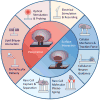Interfacing Inorganic Nanowire Arrays and Living Cells for Cellular Function Analysis
- PMID: 26349637
- PMCID: PMC4676807
- DOI: 10.1002/smll.201501236
Interfacing Inorganic Nanowire Arrays and Living Cells for Cellular Function Analysis
Abstract
Inorganic nanowires are among the most attractive functional materials, which have emerged in the past two decades. They have demonstrated applications in information technology and energy conversion, but their utility in biological or biomedical research remains relatively under-explored. Although nanowire-based sensors have been frequently reported for biomolecular detection, interfacing nanowire arrays and living mammalian cells for the direct analysis of cellular functions is a very recent endeavor. Cell-penetrating nanowires enabled effective delivery of biomolecules, electrical and optical stimulation and recording of intracellular signals over a long period of time. Non-penetrating, high-density nanowire arrays display rich interactions between the nanostructured substrate and the micro/nanoscale features of cell surfaces. Such interactions enable efficient capture of rare cells including circulating tumor cells and trafficking leukocytes from complex biospecimens. It also serves as a platform for probing cell traction force and neuronal guidance. The most recent advances in the field that exploits nanowire arrays (both penetrating and non-penetrating) to perform rapid analysis of cellular functions potentially for disease diagnosis and monitoring are reviewed.
Keywords: cell-substrate interactions, cellular function analysis; intracellular delivery; nanowire arrays; rare cell analysis.
© 2015 WILEY-VCH Verlag GmbH & Co. KGaA, Weinheim.
Figures




Similar articles
-
Microtubule-based gold nanowires and nanowire arrays.Small. 2008 Sep;4(9):1507-15. doi: 10.1002/smll.200701187. Small. 2008. PMID: 18752207
-
Highly ordered large-scale neuronal networks of individual cells - toward single cell to 3D nanowire intracellular interfaces.ACS Appl Mater Interfaces. 2012 Jul 25;4(7):3542-9. doi: 10.1021/am300602e. Epub 2012 Jun 22. ACS Appl Mater Interfaces. 2012. PMID: 22724437
-
Morphology of living cells cultured on nanowire arrays with varying nanowire densities and diameters.Sci China Life Sci. 2018 Apr;61(4):427-435. doi: 10.1007/s11427-017-9264-2. Epub 2018 Apr 2. Sci China Life Sci. 2018. PMID: 29656338
-
Recent developments in nanowires for bio-applications from molecular to cellular levels.Lab Chip. 2016 Apr 7;16(7):1126-38. doi: 10.1039/c5lc01306b. Lab Chip. 2016. PMID: 26928289 Review.
-
Recent advances in large-scale assembly of semiconducting inorganic nanowires and nanofibers for electronics, sensors and photovoltaics.Chem Soc Rev. 2012 Jun 21;41(12):4560-80. doi: 10.1039/c2cs15335a. Epub 2012 May 9. Chem Soc Rev. 2012. PMID: 22573265 Review.
Cited by
-
Tutorial: using nanoneedles for intracellular delivery.Nat Protoc. 2021 Oct;16(10):4539-4563. doi: 10.1038/s41596-021-00600-7. Epub 2021 Aug 23. Nat Protoc. 2021. PMID: 34426708 Review.
-
Recent Advances in Multifunctional Hydrogels for the Treatment of Osteomyelitis.Front Bioeng Biotechnol. 2022 Apr 25;10:865250. doi: 10.3389/fbioe.2022.865250. eCollection 2022. Front Bioeng Biotechnol. 2022. PMID: 35547176 Free PMC article. Review.
-
Fingerprinting Metabolic Activity and Tissue Integrity of 3D Lung Cancer Spheroids under Gold Nanowire Treatment.Cells. 2022 Jan 29;11(3):478. doi: 10.3390/cells11030478. Cells. 2022. PMID: 35159286 Free PMC article.
-
Enhanced capture and release of circulating tumor cells using hollow glass microspheres with a nanostructured surface.Nanoscale. 2018 Sep 13;10(35):16795-16804. doi: 10.1039/c8nr04434a. Nanoscale. 2018. PMID: 30160287 Free PMC article.
-
Semi-Implantable Bioelectronics.Nanomicro Lett. 2022 May 28;14(1):125. doi: 10.1007/s40820-022-00818-4. Nanomicro Lett. 2022. PMID: 35633391 Free PMC article. Review.
References
-
- Li Y, Qian F, Xiang J, Lieber CM. Materials Today. 2006;9(10):18. doi: 10.1016/S1369-7021(06)71650-9. - DOI
Publication types
MeSH terms
Grants and funding
LinkOut - more resources
Full Text Sources
Other Literature Sources
Miscellaneous

